-
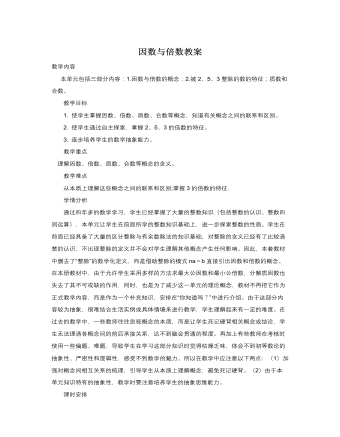
人教版新课标小学数学五年级下册因数与倍数教案
因此,本套教材中删去了“整除”的数学化定义,而是借助整除的模式na=b直接引出因数和倍数的概念。在本册教材中,由于允许学生采用多样的方法求最大公因数和最小公倍数,分解质因数也失去了其不可或缺的作用,同时,也是为了减少这一单元的理论概念,教材不再把它作为正式教学内容,而是作为一个补充知识,安排在“你知道吗?”中进行介绍。由于这部分内容较为抽象,很难结合生活实例或具体情境来进行教学,学生理解起来有一定的难度。在过去的教学中,一些教师往往忽视概念的本质,而是让学生死记硬背相关概念或结论,学生无法理清各概念间的前后承接关系,达不到融会贯通的程度。再加上有些教师在考核时使用一些偏题、难题,导致学生在学习这部分知识时觉得枯燥乏味,体会不到初等数论的抽象性、严密性和逻辑性,感受不到数学的魅力。所以在教学中应注意以下两点: (1)加强对概念间相互关系的梳理,引导学生从本质上理解概念,避免死记硬背。(2)由于本单元知识特有的抽象性,教学时要注意培养学生的抽象思维能力。
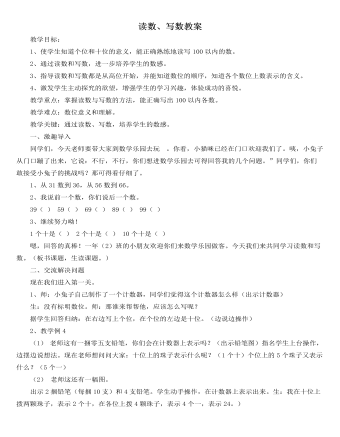
人教版新课标小学数学一年级下册读数、写数教案
教学目标:1、使学生知道个位和十位的意义,能正确熟练地读写100以内的数。2、通过读数和写数,进一步培养学生的数感。3、指导读数和写数都是从高位开始,并能知道数位的顺序,知道各个数位上数表示的含义。4、激发学生主动探究的欲望,增强学生的学习兴趣,体验成功的喜悦。教学重点:掌握读数与写数的方法,能正确写出100以内各数。教学难点:数位意义和理解。教学关键:通过读数、写数,培养学生的数感。一、激趣导入同学们,今天老师要带大家到数学乐园去玩 。你看,小猫咪已经在门口欢迎我们了。咦,小兔子从门口蹦了出来,它说:不行,不行,你们想进数学乐园去可得回答我的几个问题。”同学们,你们敢接受小兔子的挑战吗?那可得看仔细了。1、从31数到36,从56数到66。2、我说前一个数,你们说后一个数。
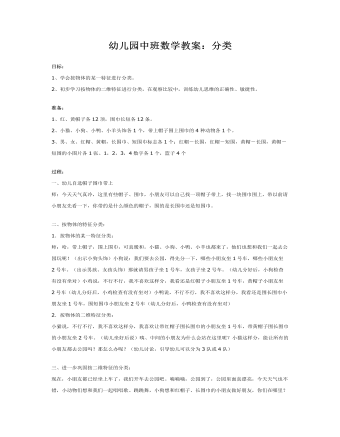
幼儿园中班数学教案:分类
准备: 1、红、黄帽子各12顶,围巾长短各12条。 2、小猫、小狗、小鸭、小羊头饰各1个,带上帽子围上围巾的4种动物各1个。 3、男、女、红帽、黄帽,长围巾、短围巾标志各1个;红帽-长围,红帽-短围,黄帽-长围,黄帽-短围的小图片各1张。1,2,3,4数字各1个,篮子4个过程: 一、幼儿自选帽子围巾带上 师:今天天气真冷,这里有些帽子、围巾,小朋友可以自己找一顶帽子带上,找一块围巾围上,带以前请小朋友先看一下,你带的是什么颜色的帽子,围的是长围巾还是短围巾。二、按物体的特征分类: 1.按物体的某一特征分类: 师:哈,带上帽子,围上围巾,可真暖和。小猫、小狗、小鸭、小羊也都来了,他们也想和我们一起去公园玩呢!(出示小狗头饰)小狗说:我们要去公园,得先分一下,哪些小朋友坐1号车,哪些小朋友坐2号车。(出示男孩、女孩头饰)那就请男孩子坐1号车,女孩子坐2号车。(幼儿分好后,小狗检查有没有坐对)小鸡说,不行不行,我不喜欢这样分,我看还是红帽子小朋友坐1号车,黄帽子小朋友坐2号车(幼儿分好后,小鸡检查有没有坐对)小鸭说,不行不行,我不喜欢这样分,我看还是围长围巾小朋友坐1号车,围短围巾小朋友坐2号车(幼儿分好后,小鸭检查有没有坐对)
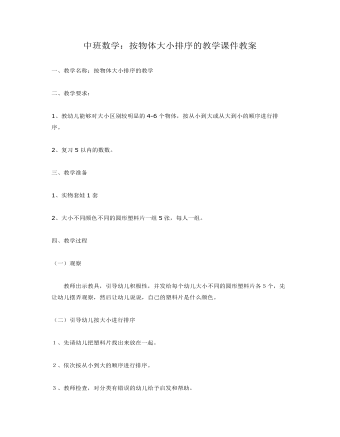
中班数学:按物体大小排序的教学课件教案
二、教学要求:1、教幼儿能够对大小区别较明显的4-6个物体,按从小到大或从大到小的顺序进行排序。2、复习5以内的数数。三、教学准备1、实物套娃1套2、大小不同颜色不同的圆形塑料片一组5张,每人一组。
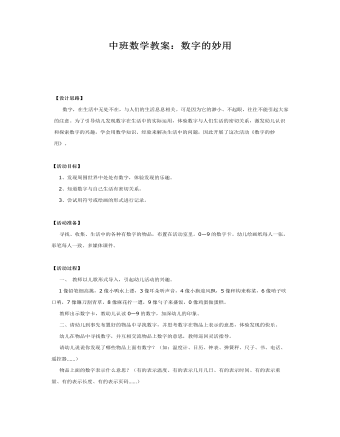
中班数学教案:数字的妙用
【活动目标】 1、发现周围世界中处处有数字,体验发现的乐趣。 2、知道数字与自己生活有密切关系。 3、尝试用符号或绘画的形式进行记录。 【活动准备】 寻找、收集、生活中的各种有数字的物品,布置在活动室里。0—9的数字卡。幼儿绘画纸每人一张,彩笔每人一致。多媒体课件。 【活动过程】 一、教师以儿歌形式导入,引起幼儿活动的兴趣。 1像铅笔细高挑,2像小鸭水上漂,3像耳朵听声音,4像小旗迎风飘,5像秤钩来称菜,6像哨子吹口哨,7像镰刀割青草,8像麻花拧一遭,9像勺子来盛饭,0像鸡蛋做蛋糕。
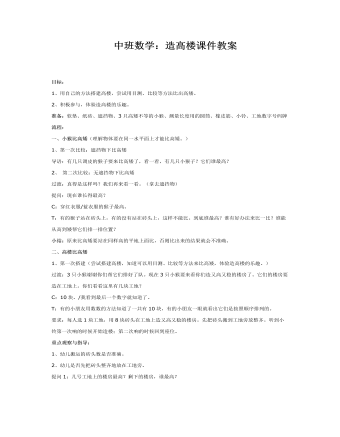
中班数学:造高楼课件教案
2、积极参与,体验造高楼的乐趣。准备:软垫、纸砖、遮挡物、3只高矮不等的小猴、测量长度用的圆筒、橡皮筋、小铃、工地数字号码牌流程:一、小猴比高矮(理解物体要在同一水平面上才能比高矮。) 1、第一次比较:遮挡物下比高矮 导语:有几只调皮的猴子要来比高矮了,看一看,有几只小猴子?它们谁最高? 2、第二次比较:无遮挡物下比高矮 过渡:真得是这样吗?我们再来看一看。(拿去遮挡物) 提问:现在谁长得最高? C:穿红衣服/蓝衣服的猴子最高。 T:有的猴子站在砖头上,有的没有站在砖头上,这样不能比。到底谁最高?谁有好办法来比一比?谁能从高到矮帮它们排一排位置? 小结:原来比高矮要站在同样高的平地上面比,否则比出来的结果就会不准确。

精编个人工匠精神学习心得体会与感受优选八篇
“创意无限,匠心支撑”。当下,创新创业大潮涌动,“互联网+”颇受青睐,大批创客投身其中。这里头有脚踏实地的深耕者,但也有不少一天到晚想着如何造噱头、拉投资,幻想借互联网的东风,“抄一把就走”之人。与此相应,很多产品往往火了一把便再无踪迹。如此“创”法,除了搅出些过时即破的泡沫,难言价值。创新创业不应成为浮躁的代名词,那些真正成功的互联网神话缔造者,远非鼓吹概念、贩卖情怀这么简单。很多大佬正是以其对细节近乎严苛的追求向大家证明,只有“互联网+工匠精神”,才能出优质产品。

精编个人学习红军长征精神心得体会与感受八篇
二万五千里长征,一次改变中国人命运的征程已在人们的评说中去过了大半个世纪。照现代社会这种急速更新换代的观念,早已是好几个时代过去了。按我们熟悉的某种号召“过去的就让它过去吧”。再说下去,就成了枭鸣似的烦扰,不免令人生厌。然而长征却不同。人们总在不断的言说、探究、拷问。我想或许是由于长征所代表的一种精神吧――一种全人类永恒追求的精神――坚持到底。 “红军不怕远征难”的精神!正因为这心中永存的信念,红军才有了“万水千山只等闲,五岭逶迤腾细浪,乌蒙磅礴走泥丸”的英雄气概!正因为这心中永存的信念,才有了“亲人送水来解渴,军民鱼水一家人”的温情!
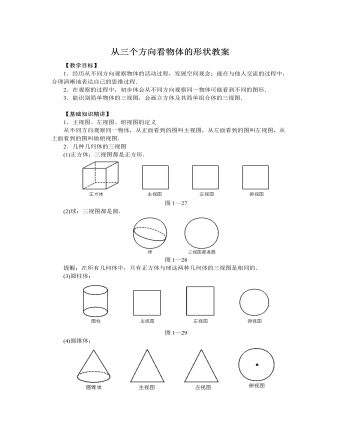
北师大初中七年级数学上册从三个方向看物体的形状教案2
【教学目标】1.经历从不同方向观察物体的活动过程,发展空间观念;能在与他人交流的过程中,合理清晰地表达自己的思维过程.2.在观察的过程中,初步体会从不同方向观察同一物体可能看到不同的图形.3.能识别简单物体的三视图,会画立方体及其简单组合体的三视图.【基础知识精讲】1.主视图、左视图、俯视图的定义从不同方向观察同一物体,从正面看到的图叫主视图,从左面看到的图叫左视图,从上面看到的图叫做俯视图.2.几种几何体的三视图(1)正方体:三视图都是正方形.圆锥的主视图、左视图都是三角形,而俯视图的图中有一个点表示圆锥的顶点,因为从上往下看圆锥时先看到圆锥的顶点,再看到底面的圆.3.如何画三视图 当用若干个小正方体搭成新的几何体,如何画这个新的几何体的三视图?

中班数学:礼物送给好妈妈课件教案
活动准备: 礼物卡片,统计表。数字1——7 活动过程: 我给妈妈送礼物 ——将礼物事先放在教室的周围桌子上 ——展示7种礼物卡,幼儿说出礼物卡上的内容,数数一共有几种礼物。 ——猜猜妈妈会喜欢那种礼物,并选择一种最想送给妈妈的礼物统计礼物的数量 ——手那相同礼物统计表的幼儿围在一起,数一数一共有几个人 ——教师出示统计表,请每组派一名幼儿早统计表上画上相应数量的符号 ——数一数那组人数最多,那组人数最少,

中班数学:动物宝宝去春游课件教案
二、活动准备: 幼儿人手一张图画纸,图纸中间是一个小动物的妈妈(教师事先画好)幼儿在动物妈妈的周围画上动物宝宝,数量以6—10不等。如小动物有小熊、孔雀、大象、等等都是幼儿熟悉的。三、活动过程: 1.天气越来越暖和了,我们小朋友去上海动物园春游,小动物看到有这么多小朋友去看它们,非常高兴,它们听说嘉定有儿童公园,它们也想来玩玩。 2.动物妈妈带了许多宝宝,我们先来帮助动物妈妈数数有几个宝宝。 (1)、幼儿人手一份图画纸,分别数数有几只动物宝宝。 重点观察:幼儿寻找被数物体的起始点和终止点并能正确进行数数。

人教版新目标初中英语七年级下册How was your weekend教案2篇
Teaching Goal:1. General aims:Talk about recent past events2. Particular aims:A. Language Focus.Talk about recent past events and think of the past events.B. Language goalsHow was….?It was …What did …do over the weekend?C. Language structures:(1). How was your weekend? I was great. Pay attention to no form.(2). What did you do over the weekend? I played soccer. We went to the beach.D. Useful words and phrases:Words: was, did, went, beach, over, project, test, wasn’t, false, number, geography, spend, week, most, mixture, their, had, little, cook, read, saw, change, everyone, sit, sat, no, anythingPhrases: did one’s homework, played soccer, cleaned my room, went to the beach, played tennis, went to the movies, on Saturday morning, over the weekend, cook … for, what about, do some reading, have a party, talk show, go shoppingE. Grammar language:Present simple past tenseRegular and irregular verbsF. Learning strategies:Tour and holidaysG. Interdiscipinary:H. Emotion and manner:Teaching time: 5 periodsTeaching procedures:Period One教学步骤、时间 教师活动 学生活动 媒体应用Step 1Free talk 3’ Ask some questions like:Who’s on duty today?What’s the weather like? Answer and talk about something.让同学们回答下列问题1. Do you like weekend? (Let some students answer)It takes them three minutes to talk about the question.2. Why do you like weekend? (let the students answer) Most of the students like the weekend此时教师用汉语问:“在周末期间问你干了什么?这句话用英语这么回答?Let the students guess.At last the teacher give them right answer3. What did you do over the weekend?(板书、学习)

人教版新目标初中英语七年级下册Where is the post office教案2篇
Period 2 (3a----Section B 2c)Preview(Pre-task): Key points: What laAdd another information about their pen pals----their language on the cardnguage does she/he speak?She/He speaks....Does she/he have any brothers and sisters? Does she/he speak English?Preview(Pre-task): Add another information about their pen pals----their language on the cardKey points: What language does she/he speak?She/He speaks....Does she/he have any brothers and sisters? Does she/he speak English?Step 1 Revision1.Revisionand dictation of the new words 2.Revise the drills they learned yesterday.(by pairwork and grammar exercise)Step 2 Leading-inT has a conversation with one student. The conversation is following:---Do you have a pen pal?---Yes, I do.---What's your pen pal's name? ---His/Her name is....---Where is your pen pal from? ---He/She is from...---Where does he/she live? ---He/She lives in....---What language does he/she speak?He/She speaks...Write the new words on the Bb. They are following: EnglishChineseJapaneseFrenchStep 3 LearnLearn the new words with the whole class.Finish 3a with the students3b Pairwork T still does an example with one student Then the Ss practise in pairs. The example is following:--Curry Muray is my pen pal. He is from the United States.---What language does he speak?

人教版新目标初中英语七年级下册Don’t eat in class教案2篇
Don’t fight. =You can’t fight. (板书,教读)教师把这些句子板书在黑板上,并请学生大声整齐地读祈使句和“can’t”句型,并让学生注意两种句型表达形式的不同和转换,“Don’t …=You can’t…”;并对学生说:These are our school rules. (板书,教读) You can’t break the school rules. Don’t break the school rules.(板书,教读)步骤3 :Practicea. T: Now, each of the students is breaking one of these rules.Please finish 1a.学生看图,完成1a的内容,检查答案并大声朗读校规。b. 听录音,完成1b,选出四位学生都违反了哪条校规;听之前,学生要读会英文名。c. 请两位学生朗读1c部分的句型;要求学生两人一组对话表演,SA扮演外校转来新生,SB告知本校校规。(学生可经过讨论,多说出他们想到的校规,不必只限于书上;教师应给予帮助)2) 第二课时(2a~4)步骤1 :warming up of revisionT: What are the rules at your school?学生使用“can”或祈使句表达各条校规;其中老师可引出“eat in the cafeteria outside”的表达。步骤2 :Practicea.T: Christina is an exchange student. She doesn’t know the rules. Let’s listen, what activities they’re talking about?学生听第一遍时,完成2a;第二遍时,完成2b;b. 请学生领读2c部分,看着2a完成的表格,理解2c活动的要求;分成小组针对2a进行问答;

人教版新目标初中英语七年级下册I want to be an actor教案2篇
三、教学建议第一课时:1. Lead in (Vocabulary)A) Before class, teacher should collect some pictures of working places. For example: Bank, TV Station, Restaurant, Police Station, Hospital ...B) In class, show students the pictures (PowerPoint, OHP). Ask students to tell the name of the working places and the name of the jobs.Shop assistant, doctor, actor, reporter, police office, waiter, bank clerk, studentC) Do exercise 1a and 3a.2. Bingo GameAsk groups of students to make up pairs of cards with a job on one and the related workplace on the other. For example, waiter / restaurant, teacher / school, doctor / hospital. Encourage students to use both the job / workplace combinations in the book and the ones that students came up during class discussions. Be sure they have twice as many sets of cards as there are students in the group. They can make two sets of cards for a single job / workplace, if necessary. Then have each group mix up its set of cards and hand their cards out in random order. Each time a student gets a pair of cards that match, he or she can lay these cards down. The goal is to have no cards in your hand at the end.3. Task OneA) Ask students to work in pairs and ask the partner what does he / she want to be in the future.e. g. :What do you / does he / does she want to be?I want to be a.Why?Because it's (adj).B) Vocabulary: Section B, 1a4. Homework 1.2.

人教版新目标初中英语七年级下册It’s raining教案2篇
1 Each group choose one place to describe and what you are doing in it Choose one place, and describe what they are doing 2 Move around the room and give suggestions Talk about it and write it down 3 Ask one to show their works and act it Choose one of each group to make a report 4 Evaluate the best group and the best reporter Choose the best one Homework Ask your friends their ideal place and write about it教学反思:新课程标准中强调学生在课堂中的主体地位,在综合课中他们的主体地位就更加突出。在各个活动中给不同程度的学生不同层次的任务,让各层面的学生都有表现发挥的机会,从而产生对英语的兴趣。使用照片图片多媒体来辅助教学,效果更好。同时让了解其他国家风景,风俗的同学介绍ideal place,增加学生的背景知知识,实现跨学科交流的目的。教案点评:采用任务型教学模式,在各个活动中给不同程度的学生不同层次的任务,让各层面的学生都有表现发挥的机会,从而产生对英语的兴趣。使用照片图片多媒体来辅助教学,效果更好。让了解其他国家风景,风俗的同学介绍ideal place,增加学生的背景知识,实现跨学科交流的目的。

人教版新目标初中英语七年级下册Why do you like koalas教案2篇
单元整体说明(一)单元教材分析本单元的核心话题是描述动物和表达个人喜好,以及句式why do you like…? Because…。这也是本单元的教学重点。通过本单元的学习,学生应能较流利地运用所学词汇和句型描述动物,表达个人喜好。(二)单元知识结构1.词汇动物名称 tiger, elephant, koala, dolphin, etc.词汇描述性形容词: smart, cute, ugly, clever, shy, etc.国家名: Australia, South Africa2.句型Why do you like koala hears? Because they are cute.Where are pandas from? They're from China.What animals do you like? I like dolphins.(三)单元整体目标1.Master the vocabulary2.Master and use: Why do you like koalas? Because they am cute.Where are pandas from? They're from China.What animals do you like? I like dolphins.(四)单元教学重难点一览(五)单元学情分析学生此前已经学过由why, where, what 引导的特殊疑问句句型,具有了学习本单元知识的认知前提。形形色色的动物能激发学生的好奇心,产生了解它们的欲望,这有利于本单元知识的教学和学生学习兴趣的培养。

人教版新目标初中英语八年级上册How was your school trip教案2篇
“Go for it!” is based on “Task-Based Language Teaching”. It adheres to “The authenticity principle”, “The form-function principle”, “The task dependency principle” and “The principle of learning by doing”. These principles all accord with the demands of curriculum focus.In and of Grade Seven (II), “Go for it!”, students have learned “The Simple Past Tense”. And it appears again in of Grade Eight (I). teaches students more about how to talk about events in the past. In addition, it gives affirmative and negative statements in the past tense, such as the sentence patterns “Did you see …?” “Were there …?” “Did you go …?” As the first part of Unit 8, Section A opens with a picture presenting the last school trip in the aquarium and continues with several step-by-step practice activities, which are all good for students to master “The Simple Past Tense”. Doing well in Section A will help students integrate the new target language with that in Section B. Thus, they can describe the events in the past freely and foster their own ability of reflecting and practicing. II. Teaching ObjectivesTeaching objective is the beginning and aim of teaching activities. According to the overall goal of the English elementary course--- improve students' synthetic ability of language application, which should be based on the development of students’ “Language knowledge”, “Language skills”, “Character building”, “Learning strategies” and “Cross-cultural awareness”. The teaching objectives are described as follows(I). Knowledge objectivesi. Master the simple past tense of regular and irregular verbsii. Recite the new words and expressions about the last school trip in the aquarium, including their pronunciation and intonation

人教版新目标初中英语八年级上册How do you get to school教案2篇
Step Ⅶ Role play ( Work on 1b)1. First ask two students to read the dialogue to the class.Sa: How do you get to school?Sb: Well, I ride my bike to the subway station. Then I take the subway.2. Now work with a partner.Suppose you use two kinds of transportation to get to school \Hangzhou\Beijing... (bus, train, subway, walking, bike, etc.) Tell how you get there. You may use the phrases in 1a.3. Then ask different pairs of students to present their conversations to the class.Step ⅧListening1. Work on 2a(1) First ask students to read the list of information that Thomas wants to know.…where Nina lives.…how far from school she lives.…how long it takes to get to school.…how she gets to school.…what she thinks of the transportation.(2) Tell students what transportation and bus stop mean.bus stop 汽车站 transportation n. 运送;运输Then tell students we'll hear a recording. Please put a checkmark in front of each thing that Thomas wants to know.(3) Now play the recording for students.( Have students pay attention to the sample answer.) (4) Then correct the answers.

人教版新目标初中英语八年级上册What are you doing for vacation教案2篇
Teaching goals : 1. Words & phrases: babysit ,get back , fishing , rent , think about , decide(on) , tourist etc. 2. How to talk about future plans . 3. 现在进行时表示将来计划或行动. 4. 特殊疑问句(where , when , how long引导) Important and difficult points : Drills :What are you doing for vacation ? I’m watching TV . When are you going ? I’m going … . How long are you staying ? We’re staying for five days . Teaching aids : cards and a tape ,a large wall calendar . Period 1 Teaching procedures : Step 1Leading in1. Free talk . 2. Put up the wall calendar . T: I’m staying home on Saturday (pointing to next Saturday ).Ss repeat . Ss: I’m staying home on Saturday . T: OK. Today we’ll learn how to talk about future plans. Step 2Pre-task SB Page 13 , 1a . 1. Look at the picture carefully and tell what you see in the picture . 2. Write the activities from the pictures in the box and add some more . 3. Practice reading . Step 3While-task1. Using the activities we write in 1a to make conversations .For example :What are you doing for vacation ? I’m visiting my uncle . 2. Pairwork .Practice in pairs . 3. 用第三人称练习对话.